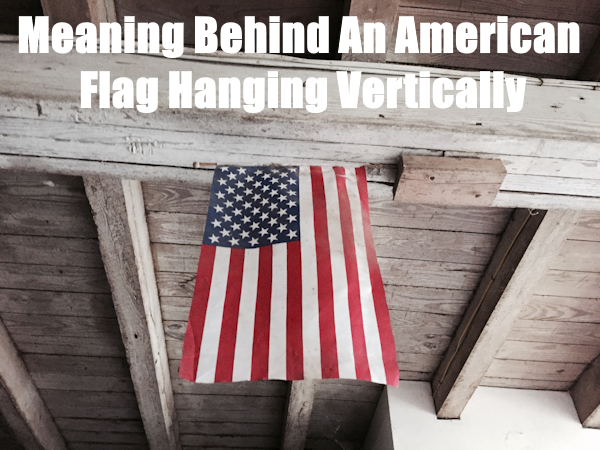What is the purpose of the American flag hanging vertically?
There are many variations of the U.S. flag, as well as many correct methods for displaying it from a building or automobile.
The U.S. Flag Code determines what type of methods are acceptable for hanging the flag.
Learn more about the meaning and purpose of the American flag hanging vertically, below.
Related Article – Upside Down American Flag Meaning: 7 Things You Didn’t Know
Table of Contents
American Flag Hanging Vertically Meaning
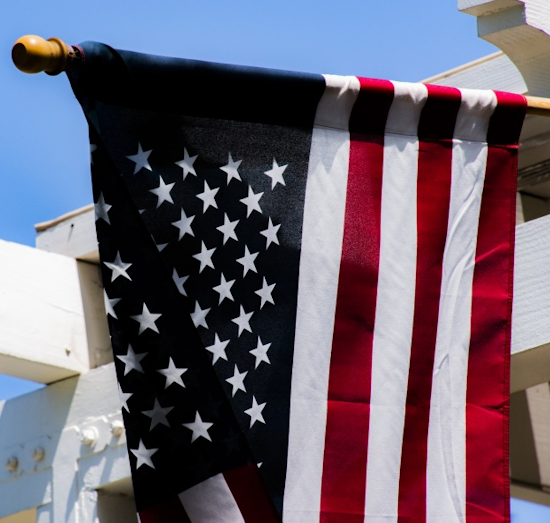
What does it mean when the American flag is hanging vertically?
In general, there is no precise meaning or explanation as to why Americans choose to hang their flag in this manner.
Nonetheless, hanging the American flag vertically is completely acceptable under the U.S. Flag Code (more information, below).
In the past, the American flag has typically been displayed horizontally atop a flagpole.
Be that as it may, U.S. citizens are free to display the flag using several other methods, including hanging it vertically.
So, mounting a flag to a pole is not the only “correct” way to display the red, white, and blue.
In fact, there are occasions (more details, below) where the U.S. Flag Code actually calls for the flag to hang vertically.
U.S. Flag Code
The U.S. Flag Code was created to ensure the proper care, handling, and display of the American flag.
As such, it’s a series of federal rules for the proper way to handle and display the U.S. flag.
It’s worth mentioning that while the U.S. Flag Code is federal law, the code is not mandatory.
Moreover, infractions of the U.S. Flag Code are rarely enforced, and controversial acts like flag burning have been defended in the past by the Supreme Court.
Nonetheless, it doesn’t hurt to comprehend the U.S. Flag Code if you care about proper etiquette and customs.
The U.S. Flag Code features a section that addresses how to properly carry the American flag.
According to the federal code, the American flag should always be carried “free and aloft” and never “flat or horizontally.”
Moreover, U.S. citizens have the right to display the flag horizontally or vertically against a wall.
Therefore, it’s been interpreted that citizens are allowed to hang the American vertically, especially in certain situations (indoors, dangling from a rope, etc.).
American Flag Hanging Vertically Etiquette
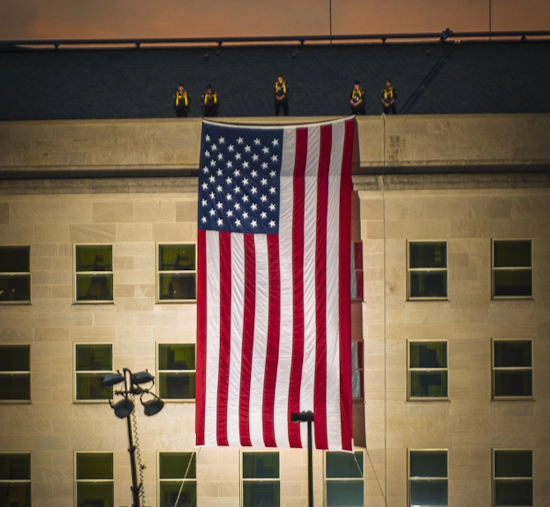
The U.S. flag, often referred to as Old Glory, is a famous American symbol of freedom and liberty.
The Star Spangled Banner captures the American spirit like few other devices in the nation.
Furthermore, the American flag honors and recognizes those who have served or are currently serving in the U.S. Armed Forces.
Accordingly, many citizens take great pride in ensuring that the method they display the flag follows the rules established in the U.S. Flag Code.
The U.S. Flag Code establishes the proper etiquette and procedure to ensure the flag is not being disrespected.
As a result, using the correct flag etiquette goes a long way toward making sure you are being patriotic while not disrespectful at the same time.
There is nothing wrong with flying the American flag vertically, so long as it follows the proper etiquette.
In general, most Americans choose to mount the U.S. flag horizontally whenever it hangs from a building or flagpole.
However, there are situations where it’s more practical to hang the flag vertically, especially if no flagpole is present.
For this reason, American flags hanging vertically are commonly found displayed inside homes or hanging from ropes outside.
In fact, the U.S. Flag Code specifies that hanging the American flag vertically is the correct method when attaching to a rope.
Therefore, this is why the U.S. flag usually hangs vertically when it hangs over a road or river.
Related Article – Here’s Why The American Flag Is Backward On Military Uniforms
Steps to Hanging an American Flag Vertically
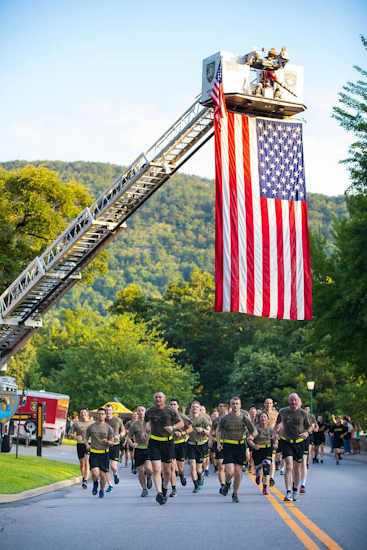
There are a few important steps to follow to make sure you are following proper etiquette when displaying the flag vertically:
- Hang the flag vertically so the union (blue square with 50 stars) is at the top.
- Hang the flag so that the union is on your left (when facing the wall).
- If hanging vertically from a flagpole, hang so the union is the furthest point from the building.
- If hanging over a street, have the union point north (if the street runs north / south) and east (if the street runs east / west).
- If hanging over a street, drape the flag vertically from a rope attached to 2 ends (and make sure the bottom of the flag doesn’t touch the ground).
The most important step to follow is to make sure the American flag is hanging vertically with the union at the top (and not the bottom).
Flying the American flag upside down is actually a sign of distress and represents a completely different meaning.
Lastly, the best way to mount a U.S. flag vertically on a wall is with tacks.
Generally, people apply the tacks through the grommets (on the flag’s top corners) to prevent the actual flag from being damaged.
Furthermore, if the flag is larger and you want to make sure it’s secure, nails can replace tacks.
U.S. Flag Etiquette Tips
Flying the American flag vertically is completely acceptable as long as the correct etiquette is followed.
Here are some easy tips for making sure you treat the American flag with respect and dignity:
- Only display the American flag from sunrise to sunset on buildings or stationary flagstaffs outdoors.
- The flag may alternatively be displayed at night with proper illumination.
- No part of the American flag should ever touch anything beneath it, including the ground.
- When placing the American flag next to other flags (state flags, military flags, etc.) the American flag is always to the observer’s left of the other flag(s).
- When displaying the U.S. flag with other flags, the union should always be the highest point (located at the peak of the staff) on a flagpole.
- If the American flag is worn or damaged, it should be “retired” by burning or burying it.
Otherwise, most conduct for displaying the American flag is acceptable as long as it is hanging from a “position of honor” and displayed in a respectful manner.
FAQs: American Flag Hanging Vertically
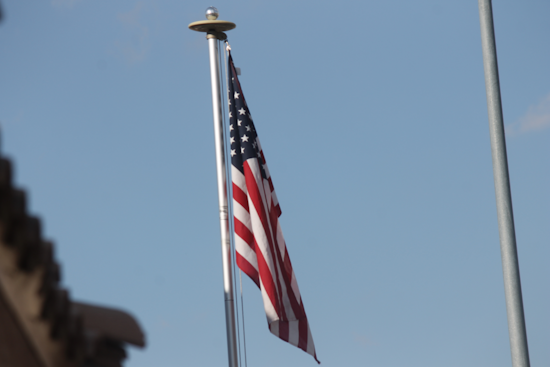
Do you have questions regarding the proper use of an American flag hanging vertically?
Here are some frequently asked questions:
Can you display an American flag vertically?
Yes, absolutely.
The U.S. Flag Code allows the flag to hang horizontally or vertically with advice on how to properly display ut.
The proper flag etiquette ensures that the American flag is being treated with respect and dignity.
Often, this is the best way to hang the American flag indoors or in the absence of a flagpole.
How do you display the American flag vertically?
There are a few simple instructions to make sure Old Glory is being displayed correctly.
First, make sure the union (blue square with 50 stars) is at the top of the flag when displaying vertically.
Secondly, the union should always be at the upper-left from the perspective of the observer (when facing the wall).
There are a few other suggestions to follow when hanging the U.S. flag outside a building (and facing a street).
Otherwise, the other guidelines are pretty straightforward (don’t let the flag touch the ground, etc.).
When can I display the U.S. flag vertically?
There are no rules for when or when you cannot display the flag vertically.
In general, popular U.S. holidays for displaying the flag include:
- Memorial Day
- Independence Day
- Veterans Day
- Flag Day
- Labor Day
Additionally, it’s not uncommon for veterans and active duty to display military flags alongside the U.S. flag.
Often, veterans (and many citizens) prefer to hang their flag year-round.
Conclusion
There are many national events that call for the display of the American flag.
Some choose to display the flag year-round while others bring it out for certain holidays and special events.
Nevertheless, it’s important to follow proper flag etiquette regardless of the occasion.
It’s permitted to fly the American flag vertically as long as a few rules and guidelines are followed.
Featured Image Source – www.Wikimedia.org
- Ikon Pass Military Discount: Learn How To Save Big - January 31, 2025
- RTIC Military Discount: Find Out How To Save Big on Gear - January 30, 2025
- Traeger Military Discount: Learn How To Save Big on Smokers - January 28, 2025

